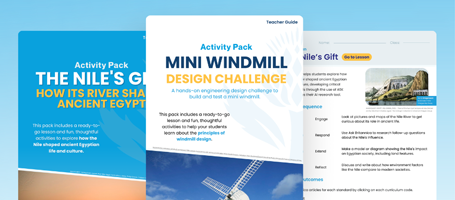What is bacteria? How do viruses reproduce? Check out the following resources to introduce your students to the science and facts behind infectious diseases.
Humans live in a world where many other living things compete for food and places to breed. Some of these—bacteria, for instance—live on and inside the human body and contribute to key bodily functions like digestion. All living organisms are continuously exposed to substances that are capable of causing them harm.
Most organisms protect themselves against microbes in more ways than one—with physical barriers like skin, for example, or with chemicals that exterminate invaders. Animals with backbones, called vertebrates, also have a more advanced protective system called the immune system.
The immune system can usually keep pathogens like viruses or bacteria from causing too much damage. But dangerous microbes do find a way in sometimes. When this happens, an immune response is triggered. In other words, you get sick.
Primary/Elementary School
Use this Britannica School (Australia) Primary Level Resource Pack ↗ to understand the cause and treatment of infectious diseases. It contains articles and multimedia.
Teacher Tip:
Schools subscribed to the UK, US, New Zealand or Asia version of Britannica School can also access this resource pack at:
Britannica School (UK) Foundation level resource pack↗
Britannica School (US) Elementary level resource pack↗
Britannica School (New Zealand) Primary level resource pack ↗
Britannica School (Asia) Elementary level resource pack ↗
Britannica School (Asia version in China) Elementary level resource pack ↗
Activity
- Use a Venn Diagram to compare being ‘sick’ to having an ‘infectious disease.’ Consider the following:
- What is an infectious disease?
- Can you give examples of infectious diseases?
- What are they caused by?
- What happens if you have an infectious disease?
- Create a table identifying Globally Infectious Diseases and their infectious agents.
- Research ways to prevent the spread of infectious diseases. Create a Behaviours Flow Chart describing these methods.
Middle School
Use this Britannica School (Australia) Middle Level Resource Pack ↗ to help you with the following activities. It contains articles and multimedia on globally significant infectious diseases, as well as treatment and prevention.
Teacher Tip:
Schools subscribed to the UK, US, New Zealand or Asia version of Britannica School can also access this resource pack at:
Britannica School (UK) Intermediate level resource pack↗
Britannica School (US) Middle level resource pack↗
Britannica School (New Zealand) Middle level resource pack ↗
Britannica School (Asia) Middle level resource pack ↗
Britannica School (Asia version in China) Middle level resource pack ↗
Activity
- The world population is about 8 billion people. How many individuals do you think die from _________ each year?
- Tuberculosis. (In 2017, TB caused an estimated 1.3 million deaths) *
- AIDS (770 000 people died of HIV-related illnesses worldwide in 2018) **
- Malaria (The estimated number of malaria deaths stood at 405 000 in 2018) ***
- Research each of the diseases above identifying the infectious agent, symptoms and treatments/cures. Record your ideas in the Globally Significant Disease Matrix.
- Examine a historical globally significant infectious disease such as Small Pox, The Black Plague or the Spanish influenza. Using the Venn diagram compare a historical globally significant infectious disease with a modern-day infectious disease.
- What advances in technology and medicine have decreased the impact of modern-day infectious diseases? Use the Observation-Inferences Chart to record your ideas.
* World Health Organisation, Global Health Observatory Data – Tuberculosis, World Health Organisation website, https://www.who.int/gho/tb/tb_text/en/, Accessed Mar 4, 2020
** World Health Organisation, Global Health Observatory Data – HIV/AIDS, World Health Organisation website, https://www.who.int/gho/hiv/en/, Accessed Mar 4, 2020
*** World Health Organisation, Malaria, World Health Organisation website, https://www.who.int/news-room/fact-sheets/detail/malaria, Jan 14 2020, Accessed Mar 4, 2020
Featured Image from Britannica School: People wearing protective surgical masks walk past a sign warning of influenza A H1N1 (swine flu) in Mexico City, Mexico, in 2009. Joe Raedle/Getty Images.
These activities and resources have been created using content from Britannica School, the go-to site for safe, comprehensive student research. Contact your librarian to find out if your institution already has access. Find out more about Britannica School or set up your own free trial.
More Educator Resources
Sign up with your email for more free resources from Britannica.

